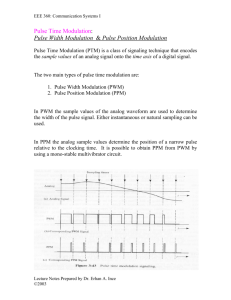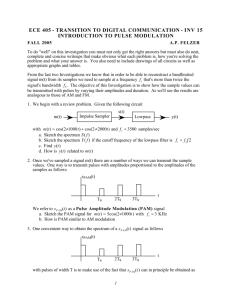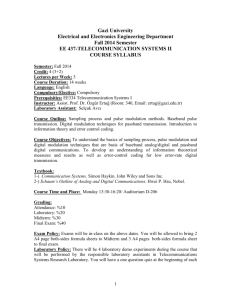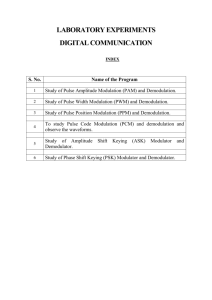ECEN 449 – Microprocessor System Design Pulse Modulation
advertisement
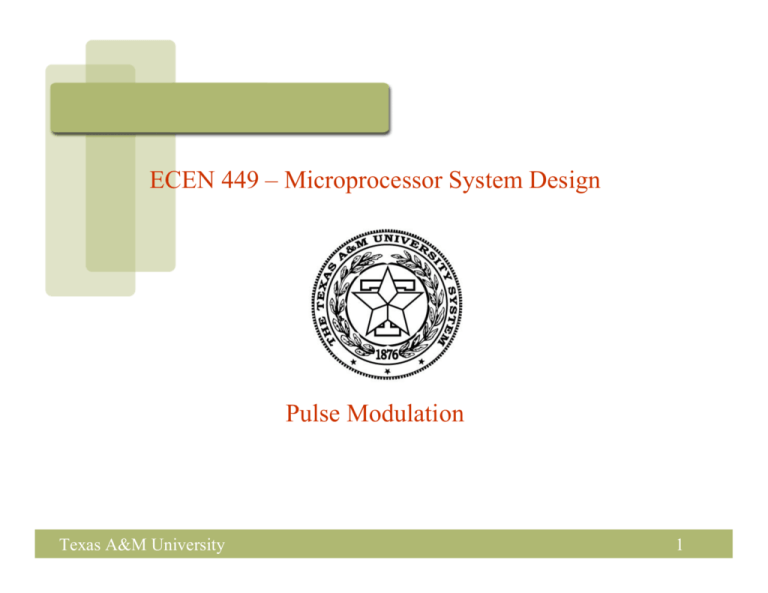
ECEN 449 – Microprocessor System Design Pulse Modulation Texas A&M University 1 Objectives of this Lecture Unit • Get familiar with pulse based communication – Different pulse modulation schemes – Applicability of these to different design scenarios Texas A&M University 2 Modulation and Communication • When we have to communicate information over a medium, we typically – Modulate the signal before transmission by the sender – Then demodulate the signal at the receiving end to retrieve the information • Why do this? – – – – The modulated signal can be transmitted with low loss Interference with other communications is avoided Receiving antennas can be made quite small Multiple signals can be multiplexed • Typical modulation schemes – amplitude, frequency, phase, code Texas A&M University 3 What is Pulse Modulation • Pulse modulation involves communication using a train of recurring pulses. • Common means of modulating data in digital communication – Key advantage is that I can send multiple signals using Time Division Multiplexing • There are several pulse modulation techniques – – – – Pulse Amplitude Modulation Pulse Width Modulation Pulse Code Modulation Pulse Position Modulation Texas A&M University 4 Pulse Amplitude Modulation (PAM) • Message information encoded in the form of the amplitude of pulses. • Pulse transmitted every T seconds, amplitude of the pulse is quantized to Q values, for PAM-Q. • Example shown above is the PAM encoded (blue) signal corresponding to a sinusoidal (red) input. Texas A&M University 5 Pulse Amplitude Modulation • Examples: – Telephone modems faster than 300 bits/sec use PAM – Ethernet uses PAM. • 100BASE-T2 as well as 1000BASE-T use PAM-5 • To achieve full-duplex operation, we can do one of two things – Use some kind of carrier sensing (as in Ethernet, which uses Carrier Sense Multiple Access) – Or use some flavor of Time Division Multiple Access. Texas A&M University 6 Pulse Width Modulation (PWM) • Here we modulate the width of pulses (or their duty cycle) to convey information. • Example above shows the PWM signal (bottom picture) corresponding to a sinusoidal signal (top picture). The PWM signal is typically generated using a sawtooth waveform and a comparator Texas A&M University 7 Pulse Width Modulation • Popular in digital circuits – Generation of PWM signal easy, demodulation typically uses counters and digital-to-analog converters (DACs) • Three flavors of PWM – Pulse center is in the center of the time window – Pulse leading edge coincides with leading edge of time window, and the trailing edge is modulated – Pulse trailing edge coincides with trailing edge of the time window, and the leading edge is modulated • Applications – Voltage regulators – Class D audio amplifiers (feed PWM signal to speaker after filtering to block carrier), which are highly efficient. Texas A&M University 8 Pulse Code Modulation (PCM) • Means to represent an analog signal in a digital manner • Sample the analog signal every T seconds, into P values. – P is usually a power of two. • Transmit log2P bits every T seconds (can do compression also) • Typically sampling is done via an ADC (Analog to Digital Converter). • Many such PCM datastreams can be multiplexed on to a high bandwidth medium in a Time Division Multiplexing (TDM) fashion. – Example voice signals sent over a phone network, or data sent over an optic fiber Texas A&M University 9 Pulse Code Modulation • Demodulation is done by collecting log2P entries, and feeding them to a Digital to Analog Converter (DAC). – Possibly need to do decompression before this. • Applications – Digital audio in computers and CDs – Straight PCM not used in video standards (DVD, DVR) since it needs a high bitrate. • Some PCM techniques transmit the difference between two adjacent samples, rather than the raw sample values. This effectively compresses the transmitted data. Texas A&M University 10 Pulse Position Modulation (PPM) • Suppose I want to send one of M message bits every T seconds. • PPM modulates the message by transmitting a single pulse in one of 2M time slots – Each time slot is T/2M seconds long • Problematic for communication media where multi-path interference dominates – Urban environments – Media which exhibit frequency-dependent fading Texas A&M University 11 Pulse Position Modulation • Commonly used in communication over optic fibers – Multi-path fading is minimal – No need for Phase-Locked Loop at the receiver (i.e. can use noncoherent receiver). Coherent receivers are prohibitively expensive for optical communication systems. • Also used in communication for RC aircraft/cars etc. – The demodulation is very simple and easy, allowing for a low-cost receiver. – Fancier RC systems use PCM (more expensive) Texas A&M University 12 Pulse Frequency Modulation (PFM) • Conceptually, we could do PFM as well. • Pulses of constant amplitude are generated, at a rate which is modulated by the signal frequency. • Problem: arrival rate of pulses is random, and hence demodulation is hard. • Therefore PFM is mostly a curiosity. Texas A&M University 13



